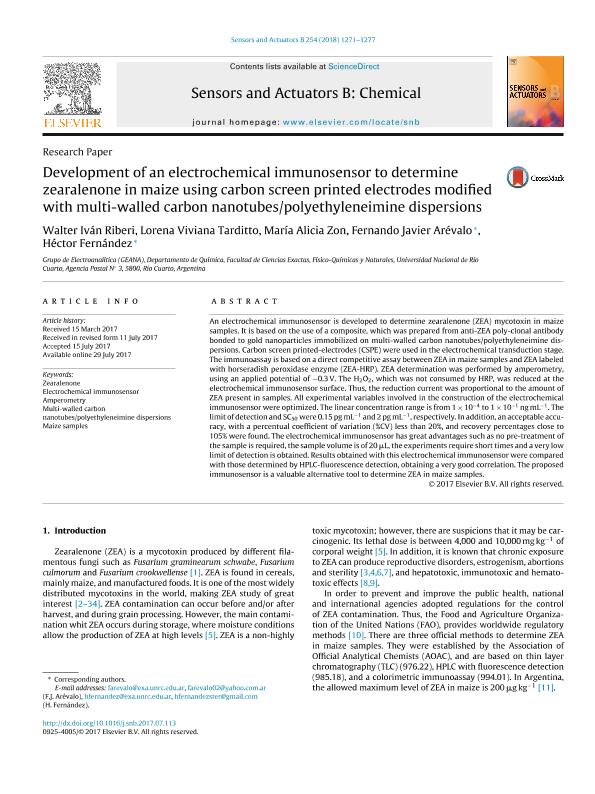Mostrar el registro sencillo del ítem
dc.contributor.author
Riberi, Walter Iván

dc.contributor.author
Tarditto, Lorena Viviana

dc.contributor.author
Zon, María Alicia

dc.contributor.author
Arevalo, Fernando Javier

dc.contributor.author
Fernandez, Hector

dc.date.available
2021-06-03T17:25:50Z
dc.date.issued
2018-01
dc.identifier.citation
Riberi, Walter Iván; Tarditto, Lorena Viviana; Zon, María Alicia; Arevalo, Fernando Javier; Fernandez, Hector; Development of an electrochemical immunosensor to determine zearalenone in maize using carbon screen printed electrodes modified with multi-walled carbon nanotubes/polyethyleneimine dispersions; Elsevier Science SA; Sensors and Actuators B: Chemical; 254; 1-2018; 1271-1277
dc.identifier.issn
0925-4005
dc.identifier.uri
http://hdl.handle.net/11336/133137
dc.description.abstract
An electrochemical immunosensor is developed to determine zearalenone (ZEA) mycotoxin in maize samples. It is based on the use of a composite, which was prepared from anti-ZEA poly-clonal antibody bonded to gold nanoparticles immobilized on multi-walled carbon nanotubes/polyethyleneimine dispersions. Carbon screen printed-electrodes (CSPE) were used in the electrochemical transduction stage. The immunoassay is based on a direct competitive assay between ZEA in maize samples and ZEA labeled with horseradish peroxidase enzyme (ZEA-HRP). ZEA determination was performed by amperometry, using an applied potential of −0.3 V. The H2O2, which was not consumed by HRP, was reduced at the electrochemical immunosensor surface. Thus, the reduction current was proportional to the amount of ZEA present in samples. All experimental variables involved in the construction of the electrochemical immunosensor were optimized. The linear concentration range is from 1 × 10−4 to 1 × 10−1 ng mL−1. The limit of detection and SC50 were 0.15 pg mL−1 and 2 pg mL−1, respectively. In addition, an acceptable accuracy, with a percentual coefficient of variation (%CV) less than 20%, and recovery percentages close to 105% were found. The electrochemical immunosensor has great advantages such as no pre-treatment of the sample is required, the sample volume is of 20 μL, the experiments require short times and a very low limit of detection is obtained. Results obtained with this electrochemical immunosensor were compared with those determined by HPLC-fluorescence detection, obtaining a very good correlation. The proposed immunosensor is a valuable alternative tool to determine ZEA in maize samples.
dc.format
application/pdf
dc.language.iso
eng
dc.publisher
Elsevier Science SA

dc.rights
info:eu-repo/semantics/openAccess
dc.rights.uri
https://creativecommons.org/licenses/by-nc-sa/2.5/ar/
dc.subject
AMPEROMETRY
dc.subject
ELECTROCHEMICAL IMMUNOSENSOR
dc.subject
MAIZE SAMPLES
dc.subject
MULTI-WALLED CARBON NANOTUBES/POLYETHYLENEIMINE DISPERSIONS
dc.subject
ZEARALENONE
dc.subject.classification
Química Analítica

dc.subject.classification
Ciencias Químicas

dc.subject.classification
CIENCIAS NATURALES Y EXACTAS

dc.title
Development of an electrochemical immunosensor to determine zearalenone in maize using carbon screen printed electrodes modified with multi-walled carbon nanotubes/polyethyleneimine dispersions
dc.type
info:eu-repo/semantics/article
dc.type
info:ar-repo/semantics/artículo
dc.type
info:eu-repo/semantics/publishedVersion
dc.date.updated
2021-06-02T12:14:16Z
dc.identifier.eissn
1873-3077
dc.journal.volume
254
dc.journal.pagination
1271-1277
dc.journal.pais
Países Bajos

dc.journal.ciudad
Amsterdam
dc.description.fil
Fil: Riberi, Walter Iván. Universidad Nacional de Río Cuarto. Facultad de Ciencias Exactas Fisicoquímicas y Naturales. Departamento de Química; Argentina. Consejo Nacional de Investigaciones Científicas y Técnicas. Centro Científico Tecnológico Conicet - Córdoba; Argentina
dc.description.fil
Fil: Tarditto, Lorena Viviana. Universidad Nacional de Río Cuarto. Facultad de Ciencias Exactas Fisicoquímicas y Naturales. Departamento de Química; Argentina. Consejo Nacional de Investigaciones Científicas y Técnicas. Centro Científico Tecnológico Conicet - Córdoba; Argentina
dc.description.fil
Fil: Zon, María Alicia. Universidad Nacional de Río Cuarto. Facultad de Ciencias Exactas Fisicoquímicas y Naturales. Departamento de Química; Argentina. Consejo Nacional de Investigaciones Científicas y Técnicas. Centro Científico Tecnológico Conicet - Córdoba; Argentina
dc.description.fil
Fil: Arevalo, Fernando Javier. Universidad Nacional de Río Cuarto. Facultad de Ciencias Exactas Fisicoquímicas y Naturales. Departamento de Química; Argentina. Consejo Nacional de Investigaciones Científicas y Técnicas. Centro Científico Tecnológico Conicet - Córdoba; Argentina
dc.description.fil
Fil: Fernandez, Hector. Universidad Nacional de Río Cuarto. Facultad de Ciencias Exactas Fisicoquímicas y Naturales. Departamento de Química; Argentina. Consejo Nacional de Investigaciones Científicas y Técnicas. Centro Científico Tecnológico Conicet - Córdoba; Argentina
dc.journal.title
Sensors and Actuators B: Chemical

dc.relation.alternativeid
info:eu-repo/semantics/altIdentifier/url/https://www.sciencedirect.com/science/article/pii/S0925400517313217
dc.relation.alternativeid
info:eu-repo/semantics/altIdentifier/doi/http://dx.doi.org/10.1016/j.snb.2017.07.113
Archivos asociados
